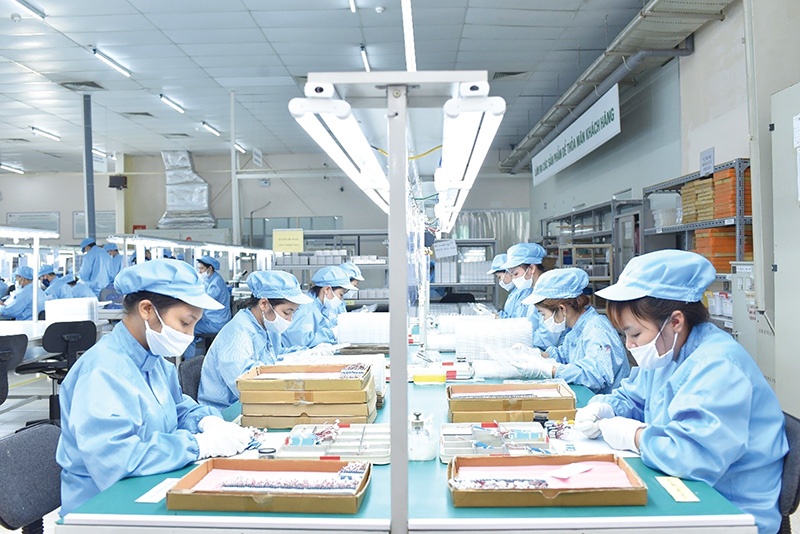Labour market prepares for post-holiday season
 |
| Labour market prepares for post-holiday season |
Many urban centres playing the role of major labour markets in Vietnam have begun to recover after last year’s pandemic depths.
According to forecasts from the Centre of Forecasting Manpower Needs and Labour Market Information in Ho Chi Minh City, it is expected that the city will have more than 4.9 million workers, of which industry and construction account for 37 per cent and the commercial and service sectors account for around 62 per cent.
The recruitment demand in the city is forecast to reach 255,000-280,000 in 2022 and could rise to 310,000 if the pandemic is kept under sufficient control.
Le Minh Tan, director of Ho Chi Minh City Department of Labour, War Invalids and Social Affairs, said that almost 99 per cent of private and foreign-invested enterprises are in need of recruiting more workers, and demand for trained professional and technical workers has increased to 86 per cent.
“To support workers to return to work after Lunar New Year, the city will have specific policies on low-cost social housing, lobby inn owners to reduce room rents, and organising accommodation for workers in industrial parks and export processing zones,” said Tan.
Up in Hanoi, Vu Quang Thanh, deputy director of the Hanoi Centre of Employee Services, said the labour market will continue to prosper in Q1/2022 as businesses step up production and business activities to complete orders for the holidays.
“In my experience, businesses often plan to recruit new employees, so demand will increase, leading to better job search demand as well as a better source of labour,” Thanh forecasted.
He added that the areas with the most demand will likely be manufacturing and processing, e-commerce, logistics, transportation, warehousing, and a number of occupations in data analysis and international trade. This is also true for several traditional occupations that experienced a sharp increase in recruitment demand last year such as IT, finance and banking, and insurance.
Although there have been initial positive signs of a recovery, many experts fear that the Vietnamese labour market still faces an uphill struggle to recovery, requiring management agencies and businesses to make more efforts in creating jobs for workers.
“Due to the pandemic, the underemployment rate in urban areas is higher than in rural areas. This is different from the trend generally observed in the labour market in previous years,” a representative of the General Statistics Office said.
A report on global employment and social trends for this year from the International Labour Organization shows that, along with the increase in the global unemployment rate, the number of unemployed workers in Vietnam in 2022 is estimated at 1.3 million people, an increase of 100,000 people compared to 2021 and equivalent to that of 2020. The number of unemployed workers in 2023 is expected to fall to the 2021 unemployment level but still remain above the 2019 level at 1.1 million.
In order to recover the labour market, experts believe that it is necessary to develop and implement programmes and policies to encourage workers, especially young people, to improve their qualifications and equip themselves with the necessary skills to meet the requirements of production and business recovery of the economy. At the same time, it is required to study appropriate fiscal policies to stimulate investment demand, expand production, create jobs for workers, and stimulate the recovery of economic growth.
“Enterprises cannot restore the labour market and production on their own. Therefore, it is necessary to have backup support funds for businesses to attract workers to return to work after Lunar New Year,” said Nguyen Thi Lan Huong, former director of the Institute of Science, Labour, and Social Affairs.
Huong added that after a period of stagnation, new segments and new skills will also be formed. Therefore, in order to support groups of workers who lost their jobs to return to the market, it is necessary to have synchronous solutions to change the job structure and make up for skills that have been lacking. New workers entering the market also need to improve their professional knowledge, especially adapting to new job requirements in all situations.
What the stars mean:
★ Poor ★ ★ Promising ★★★ Good ★★★★ Very good ★★★★★ Exceptional
Related Contents
Latest News
More News
- Businesses ramp up production as year-end orders surge (December 30, 2025 | 10:05)
- Vietjet chairwoman awarded Labour Hero title (December 29, 2025 | 13:06)
- How to unlock ESG value through green innovation (December 29, 2025 | 10:03)
- AI reshapes media and advertising industry (December 29, 2025 | 08:33)
- FPT and GELEX sign deal to develop blockchain tech for global markets (December 29, 2025 | 08:29)
- Vietnam’s GDP forecast to grow by 9 per cent in 2026 (December 29, 2025 | 08:29)
- Women entrepreneurs are key to Vietnam’s economic growth (December 29, 2025 | 08:00)
- Vietnam's top 500 value-creating enterprises announced (December 27, 2025 | 08:00)
- The PAN Group shaping a better future with ESG strategy (December 26, 2025 | 09:00)
- Masan Consumer officially lists on HSX, marking the next phase of value creation (December 25, 2025 | 13:20)

 Tag:
Tag:




















 Mobile Version
Mobile Version